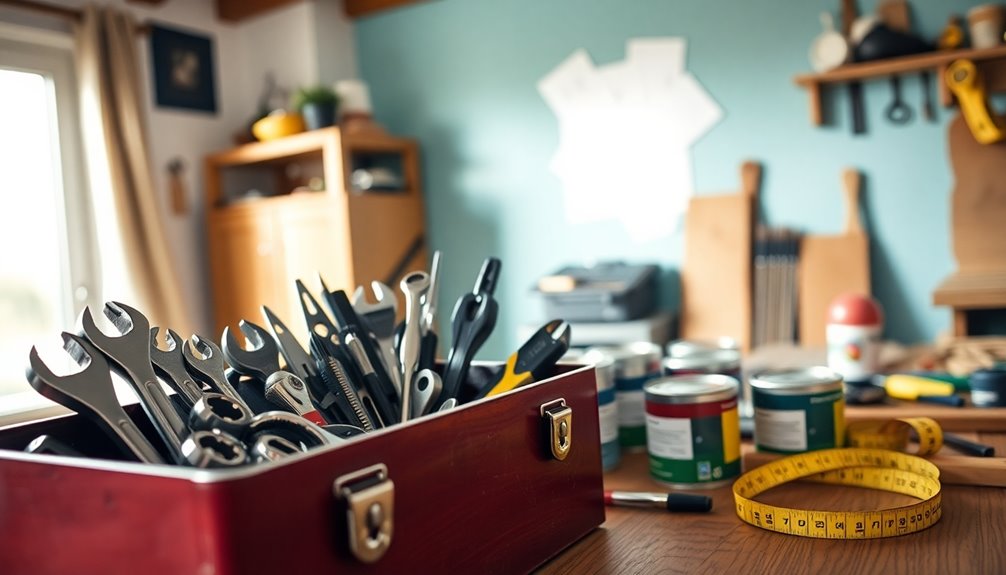To make home repairs easier on your wallet, start by establishing a rainy day fund to cover unexpected costs. Use DIY skills for simple fixes like leaky faucets, saving you cash on labor. Regular maintenance, like cleaning gutters and inspecting your roof, can prevent bigger issues down the line. Compare prices for materials and gather quotes to find the best deals. Don't hesitate to tap into your personal network for help or skill-sharing. These strategies can considerably lower your expenses and keep your home in great shape. Want to discover more tips and tricks? There's plenty more to explore!
Establish a Rainy Day Fund
When it comes to home repairs, having a financial cushion can make all the difference. Establishing a rainy day fund of at least £1,000 gives you the security needed to tackle unexpected repair costs without stress. You never know when a leaky roof or a broken furnace might strike, so it's wise to prepare in advance.
To build your rainy day fund, consider contributing monthly. Aim for setting aside 1% to 4% of your home's value annually. This consistent approach not only helps grow your savings but also guarantees you're ready for any emergencies that arise. Additionally, utilizing expense tracking tools can provide you with insights into your spending habits and help you allocate funds more effectively. Regularly tracking your expenditures promotes financial awareness, allowing for more informed decisions regarding your savings.
Utilize high-interest savings accounts to maximize your fund's potential, letting your money work for you over time. Having this dedicated fund means you won't have to rely on loans during a crisis, which can save you from accruing hefty interest payments. Additionally, implementing a budgeting app can help you track your progress and ensure you stay on target with your savings contributions.
Plus, knowing you've got a financial backup eases the stress during those urgent repair situations. So, take the time to establish your rainy day fund today, and you'll find that home repairs become less intimidating when you're financially prepared.
Utilize DIY Skills
Having a rainy day fund sets the stage for tackling home repairs without financial strain, but knowing how to address those repairs yourself can save even more money. Simple DIY projects, like fixing a leaky faucet, can be done by replacing washers or O-rings, potentially saving you around $200 in plumber fees. Many of these savings can be tracked using expense tracking apps, which help manage costs efficiently. Additionally, utilizing automated investment management tools can help you save for future repairs more effectively.
With the wealth of online resources available, including YouTube tutorials and DIY blogs, you can easily find step-by-step guidance for various home maintenance tasks. Investing in a basic toolkit—think wrenches, screwdrivers, and plungers—will empower you to handle numerous repairs on your own, cutting down on additional costs. Don't overlook community workshops, often offering free or low-cost training in home repair skills. These can enhance your self-sufficiency and reduce your reliance on professional services. Plus, local home improvement stores frequently have knowledgeable staff ready to provide advice and tips on DIY projects, helping you make informed decisions and avoid costly mistakes.
In addition, utilizing expense management apps can help you keep track of costs associated with home repairs, ensuring you stay within budget.
Leverage Personal Network

Tapping into your personal network can greatly cut costs on home repairs. Start by asking friends or family for help; they might offer their skills or labor at reduced rates or even for free. This can considerably lower your repair costs and provide financial protection against unexpected expenses. Additionally, many people in your network may be knowledgeable about sustainable practices that can help you make eco-friendly choices while completing repairs. Utilizing tools like budget management software can further enhance your financial planning as you navigate expenses.
Building relationships with skilled professionals within your network—like plumbers or electricians—can also lead to savings. Friends might refer you to someone who can offer discounted services.
Additionally, engaging in skill-sharing with acquaintances enhances your DIY capabilities, allowing you to tackle more complex repairs without incurring high costs. Consider also coordinating shared grocery deliveries, as this can reduce overall expenses and promote community sustainability in your local area.
Consider hosting a repair party where everyone pitches in to help with various home projects. This not only fosters a sense of community but also reduces individual expenses while you all learn from one another, potentially inspiring sustainable fashion choices through collaborative efforts.
Lastly, networking within your community can open doors to local workshops and classes, boosting your repair skills further. By leveraging your personal network, you not only save money on repairs but also build valuable connections that can aid you in future home improvement endeavors.
Compare Repair Quotes
Comparing repair quotes is a crucial step in managing home repair costs effectively. When you obtain multiple quotes for significant repairs, you can identify the best prices and services available. This not only saves you money but also gives you a clearer understanding of the scope of work and materials required for your repairs.
Don't forget to research online for discounts or promotions on company websites and social media. You might find some great deals that further reduce your costs. Additionally, consider seasonal pricing variations; for example, scheduling heating repairs in the summer can lead to lower rates and reduced service fees. Utilizing price comparison tools can help ensure you find the best deals available in the market.
Some service providers also offer interest-free payment plans, which can ease the financial burden of larger, costly repairs. By taking the time to compare quotes, you're not just looking for the cheapest option—you're ensuring quality work at a fair price. Ultimately, this careful approach can help you avoid unexpected expenses down the line, keeping your home repair budget intact. So, gather those quotes, do your homework, and make informed decisions that benefit both your wallet and your home.
Invest in Preventive Maintenance
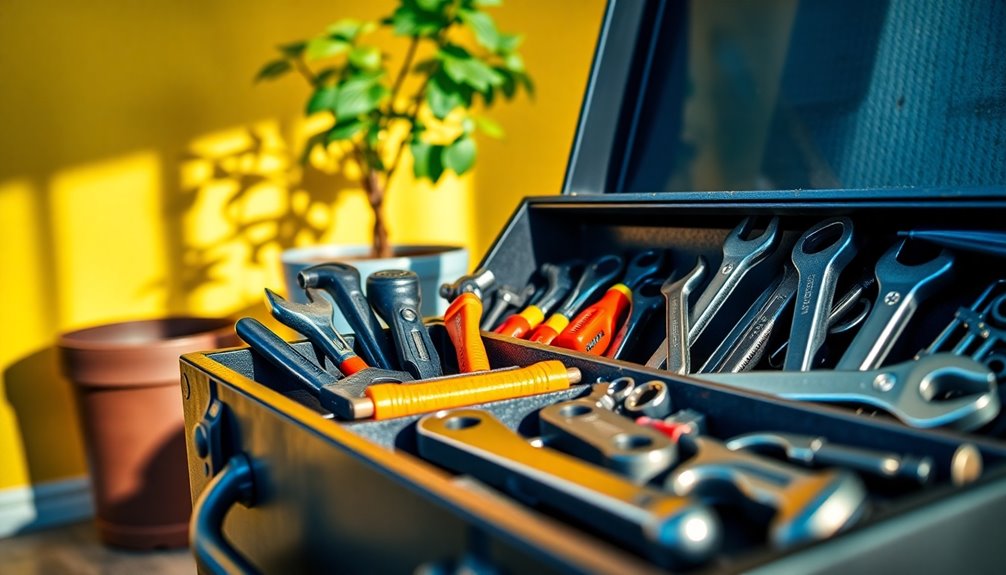
After securing the best quotes for repairs, it's smart to think about how preventive maintenance can save you even more in the long run. By regularly maintaining your home, you can avoid the headache of major repairs that often come with unexpected breakdowns.
For instance, changing your HVAC filters monthly not only keeps your system running efficiently but also extends its lifespan, saving you significant amounts over time. Budgeting apps can help you track the costs associated with these maintenance tasks, ensuring that you stay within your budget. Additionally, using investment tracking tools can provide insights into your overall financial health, allowing you to allocate funds effectively for home maintenance.
Routine inspections of your appliances and plumbing systems can help you catch minor issues before they escalate into costly major repairs. In fact, addressing these small problems early could save you hundreds or even thousands of dollars.
Establishing a maintenance schedule for key systems guarantees that you stay proactive, preventing disruptions in your daily life.
Utilizing quality materials and proper maintenance techniques will enhance the durability of your home features, reducing both the frequency and cost of repairs over time.
The average emergency repair cost was $1,953 in 2022, so investing in preventive maintenance now can help you avoid such expenses later. By incorporating regular reviews of savings and investments into your maintenance strategy, you can ensure that your financial health supports your home upkeep.
Fixing a Leaky Faucet
If you're dealing with a leaky faucet, understanding the common causes is your first step to a fix.
Usually, worn-out washers or O-rings are to blame, and replacing them is simpler than you might think. Additionally, recognizing the importance of expense categorization can help you budget for home repairs effectively.
Let's break down the easy steps to get your faucet back in shape and save water while you're at it.
Common Causes Explained
A leaky faucet can be a frustrating issue, but understanding its common causes can make fixing it a breeze.
One of the most frequent culprits behind leaky faucets is worn-out washers or O-rings. Over time, these components can degrade, leading to leaks. The good news is that replacing them is usually simple and inexpensive—often costing under $5.
Regular maintenance can help you catch these problems before they escalate.
For example, a small leak mightn't seem significant, but it can waste about 3,000 gallons of water annually if left unchecked. That's a significant amount, not just for the environment but also for your wallet.
Simple Repair Steps
Fixing a leaky faucet is easier than you might think, and with just a few simple repair steps, you can tackle it yourself.
Start by gathering basic tools like a wrench and a screwdriver. Before you begin, make sure to shut off the water supply to prevent any flooding or water wastage.
Next, remove the faucet handle by loosening the screw, then lift it off. You'll likely find a worn-out washer or O-ring that's causing the leak. Take the old part to your local hardware store to find an exact replacement.
Once you've got the new parts, install them by properly aligning and securing them. This step is essential to avoid future leaks.
After reassembling the faucet, turn the water supply back on and check for leaks. If all's well, you've just made a small repair that can save you money on your water bill—those leaky faucets can waste over 3,000 gallons of water a year!
Repairing Drywall Holes
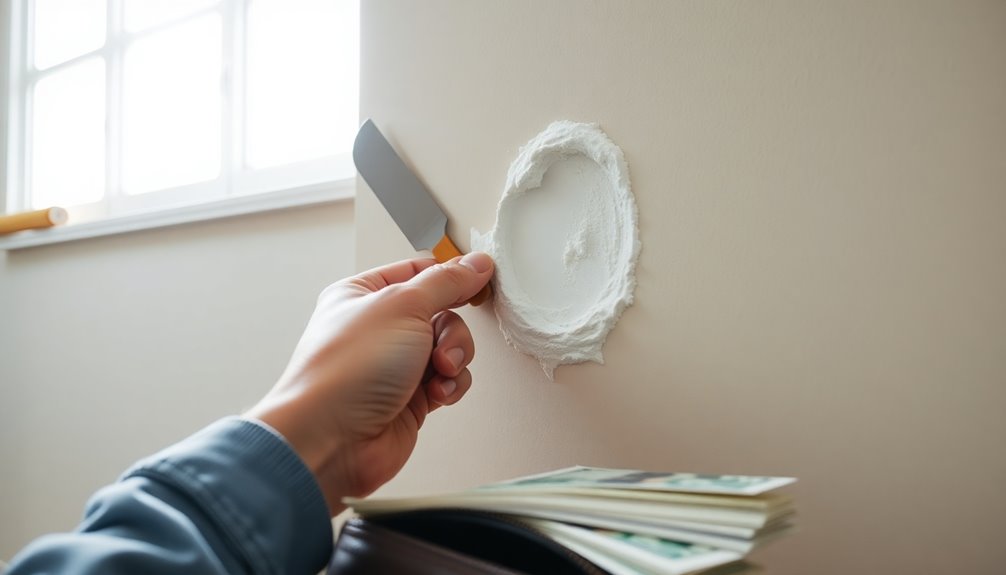
Often, small drywall holes pop up unexpectedly, leaving you wondering how to tackle the repair. Fortunately, a patch kit is a cost-effective solution, typically costing less than £10. Simply clean the area, apply the patch, and finish it with some joint compound for a smooth look.
If you're dealing with larger holes, you'll need to cut a piece of new drywall to fit the space. Apply joint compound around the edges, then sand the area down for a seamless finish. This project usually runs under £50 and can save you a significant amount compared to hiring a pro.
By handling your drywall repairs yourself, you can save an average of £100 per repair, making home repairs easier on your wallet.
Plus, properly repairing drywall not only enhances the aesthetics of your room but also prevents potential issues like mold growth from moisture entering through holes.
Regular maintenance and timely repairs can extend the lifespan of your walls, ultimately protecting your home's value.
Unclogging Drains
When drains start acting up, you can usually tackle the problem without calling in a plumber. Minor clogs can often be resolved with a trusty plunger, a cost-effective tool that most households have on hand.
If the blockage is stubborn, consider using a drain snake or auger to manually remove the clogs. These tools allow you to handle the issue without spending money on professional help.
For a natural approach, try a homemade solution. A mixture of baking soda and vinegar works wonders to break down grease and debris, saving you cash on chemical cleaners.
Regular maintenance is key to preventing future clogs. Flushing your drains with hot water and vinegar monthly can keep them clear and reduce the need for costly repairs.
It's also wise to avoid chemical drain cleaners. Not only can they damage your pipes, leading to expensive repairs, but they also don't address the root cause of clogs.
Replacing Light Fixtures
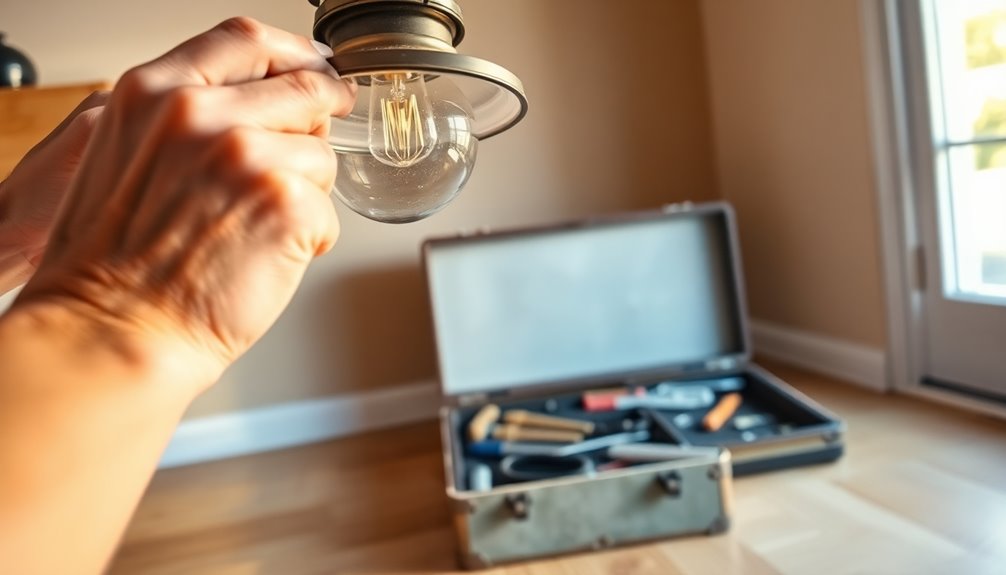
Replacing light fixtures is a simple yet impactful way to elevate your home's ambiance and energy efficiency. This cost-effective home improvement project can dramatically enhance the overall aesthetics of any room.
Before you start, you'll need some basic electrical knowledge. Always turn off the power at the circuit breaker to avoid any safety hazards during installation.
Once you've confirmed that the power is off, grab your new light fixture and follow the provided installation instructions. Most fixtures come with detailed steps that make it easy for homeowners like you to complete the setup successfully.
Upgrading to energy-efficient LED fixtures can lead to long-term savings on your electricity bills, as they consume considerably less energy compared to traditional incandescent bulbs.
Regularly replacing outdated or damaged fixtures not only updates your decor but also helps prevent potential fire hazards and improves the lifespan of your home's electrical system.
By taking the initiative to replace your light fixtures, you're making a smart investment in both your home's safety and aesthetic appeal.
Fixing a Running Toilet
If you've just upgraded your light fixtures, you might notice other areas in your home that need attention, like a running toilet. This common household issue can waste up to 200 gallons of water per day, considerably boosting your water bill.
Addressing it promptly is essential for saving money.
Common causes of a running toilet include a faulty flapper, fill valve, or flush valve. Thankfully, these parts are inexpensive, often costing less than $20 each. You only need a few basic tools, like a screwdriver and a wrench, to tackle this manageable DIY repair.
To fix a leaky toilet, start by identifying the faulty component. Usually, replacing the flapper or fill valve will solve the problem.
Many home improvement stores offer toilet repair kits that include all the necessary parts, making it easy to get everything you need in one go.
Regular maintenance checks can help you catch issues early, potentially saving you hundreds of dollars in water bills over time.
Re-caulking Bathtub and Shower
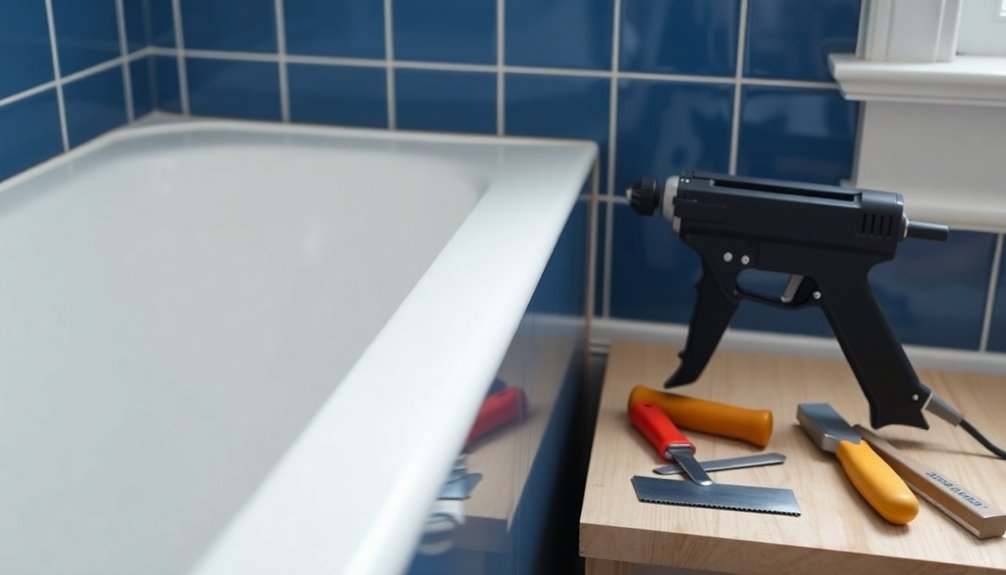
Maintaining a watertight seal around your bathtub and shower is essential for preventing leaks and mold growth, which can lead to costly repairs down the line.
Re-caulking is a simple yet effective way to protect your bathroom from potential water damage. Here's how to tackle this DIY project:
- Remove Old Caulk: Use a utility knife to carefully cut away the old caulk. Make sure to clean the area thoroughly afterward.
- Choose Quality Caulk: Opt for a high-quality, mildew-resistant silicone caulk. This not only enhances the aesthetics but also extends the lifespan of your repair.
- Apply New Caulk: Once the area is clean and dry, apply the new caulk evenly, ensuring a tight seal.
- Allow to Cure: Let the caulk cure according to the manufacturer's instructions before using the shower or bathtub.
Cleaning Gutters
Cleaning your gutters regularly is essential for preventing costly water damage to your home.
With just a few simple techniques and some basic tools, you can keep your gutters clear and functional.
Let's explore the best practices for maintaining your gutters without breaking the bank.
Importance of Regular Cleaning
Regular gutter cleaning is essential for protecting your home from water damage and costly repairs. Clogged gutters can lead to significant issues, including water overflowing and damaging your siding, windows, and doors.
By keeping your gutters clean, you can save yourself thousands in potential home repairs.
Here's why regular cleaning should be a priority:
- Prevent Water Damage: Proper drainage prevents water from accumulating around your foundation, reducing the risk of costly repair bills.
- Save Money: Average repair costs for water damage can range from $1,000 to $4,000, a burden that could deplete your emergency fund.
- DIY Friendly: Cleaning gutters is a simple task that requires minimal tools, making it cost-effective compared to hiring professionals.
- Install Gutter Guards: Consider adding gutter guards to decrease debris buildup, which can lower maintenance costs and protect your home investment.
Simple Cleaning Techniques
Often overlooked, gutter maintenance is essential for keeping your home safe from water damage. Cleaning gutters regularly, ideally twice a year, helps prevent costly repairs that can arise from clogged systems.
To get started, grab a sturdy ladder, gloves, and a scoop. Carefully climb up and remove any debris, ensuring your gutters are clear to facilitate proper water flow and prevent overflow.
Clogged gutters can lead to serious problems, like mold growth, rotting wood, and insect infestations, which can incur additional repair costs if not addressed promptly. By regularly cleaning your gutters, you not only maintain your home's integrity but also save yourself from potential headaches down the line.
Consider installing gutter guards to reduce the frequency of cleaning needed. These can minimize debris accumulation, making maintenance easier and more cost-effective over time.
Cost-Effective Tools Needed
Equipping yourself with the right tools makes gutter maintenance much easier and safer. By investing in a few cost-effective tools, you can avoid large repairs down the line caused by clogged gutters.
Here's a list of essential items to get you started:
- Sturdy Ladder: Confirm it's tall enough for your roof height and stable enough to support you while you work.
- Gloves: Protect your hands from sharp debris and dirt while cleaning.
- Gutter Scoop or Trowel: These tools help you effectively remove leaves and muck from your gutters.
- Garden Hose with Spray Nozzle: Use this to flush out any remaining debris and check for proper drainage once you're done.
Additionally, consider a gutter cleaning attachment for your leaf blower to save time.
For safety, a harness or stabilizer is vital when working at heights.
Regularly cleaning your gutters at least twice a year can prevent costly water damage to your home's foundation and roof.
With these tools, you'll make gutter maintenance a breeze and protect your wallet from unexpected repair costs.
Painting Walls

Transforming your living space with a fresh coat of paint doesn't have to break the bank. Painting walls can dramatically enhance a room's appearance at a relatively low cost. With an average gallon of paint priced between $20 to $60, you can achieve a stunning transformation without overspending.
Start by preparing your surfaces; cleaning and sanding them can greatly improve paint adhesion. This preparation helps you avoid multiple coats, saving both time and money.
Using painter's tape for clean edges will prevent the need for touch-ups, allowing your project to look polished without incurring extra expenses.
While it might be tempting to choose the cheapest option, investing in high-quality paint is wise. It typically requires fewer coats and lasts longer, reducing the frequency of repainting.
Plus, tackling this project yourself can save you hundreds of dollars compared to hiring professional painters.
Sealing Windows and Doors
Sealing your windows and doors is one of the simplest ways to boost your home's energy efficiency.
By using cost-effective solutions like weatherstripping and caulking, you can prevent drafts and save on those pesky utility bills.
Plus, these easy fixes can help extend the life of your heating and cooling systems, saving you even more in the long run.
Energy Efficiency Improvement
One of the simplest ways to boost your home's energy efficiency is by sealing windows and doors.
This energy efficiency improvement not only cuts down on drafts but can also save you up to 20% on your energy bills. Sealing these openings enhances insulation, contributing to your home's overall value.
Here are four effective steps you can take:
- Use Weather Stripping: Materials can cost as little as $0.50 per foot. It's an affordable way to eliminate gaps around doors and windows.
- Apply Caulk: Resealing with caulk can save you an average of $100 annually by preventing air leaks, markedly reducing heating and cooling costs.
- Add Insulation Film: Improving your windows with insulation film can enhance energy efficiency by up to 90% during winter months, leading to substantial savings.
- Regular Maintenance: Regularly check and reseal any openings to lower your overall energy consumption and reduce your carbon footprint.
Cost-Effective Weatherproofing Solutions
Improving your home's energy efficiency can lead to significant savings, and weatherproofing is a key component. Sealing windows and doors effectively can save you up to 20% on energy bills by reducing drafts and boosting insulation. A cost-effective method to start is using weatherstripping materials, which range from $0.50 to $2.00 per foot. These materials can easily seal gaps around your windows and doors.
Additionally, caulking gaps and cracks is essential to prevent moisture intrusion. This simple repair can save you from potential water damage costs, which can average $2,000 to $5,000.
Applying window film is another smart choice; it can enhance insulation by up to 92% at a price of $5 to $15 per roll.
Don't forget that regular maintenance and resealing every few years can extend the lifespan of your windows and doors, reducing the need for costly replacements in the long run.
Addressing Minor Roof Repairs
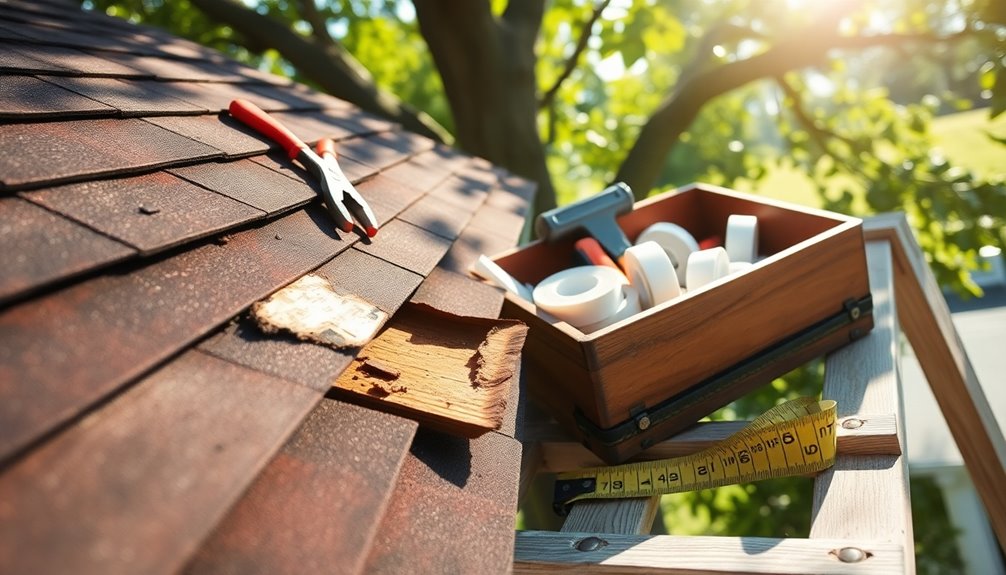
While you might think roof repairs require a professional, addressing minor issues like damaged shingles can be a straightforward DIY task.
By tackling minor roof repairs yourself, you can save considerably on labor costs and prevent small problems from escalating into major headaches.
Here's how to get started:
- Inspect Your Roof: Look for signs of damage, such as missing or cracked shingles, and check for leaks. Regular inspections can help catch issues early.
- Gather Tools and Materials: Invest in a DIY roof repair kit, which typically includes roofing cement, shingles, and basic tools like a ladder and a pry bar.
- Replace Damaged Shingles: Remove the damaged shingles carefully and replace them with new ones from your DIY roof repair kit. Apply roofing cement to seal the edges.
- Maintain Your Roof: Regular maintenance will extend its lifespan. Keep the area clear of debris and check for new damage after storms.
Conclusion
By following these tips, you can make home repairs less of a financial burden. Establishing a rainy day fund and leveraging your DIY skills can save you significant cash. Don't forget to reach out to friends for help or compare repair quotes to find the best deal. After all, who wouldn't want to keep their home in shape without breaking the bank? With a little effort and planning, you can protect your wallet while maintaining your home.

